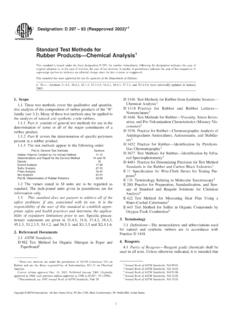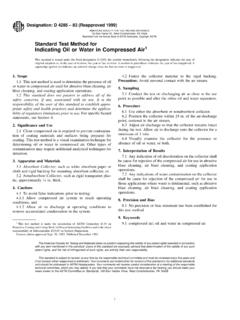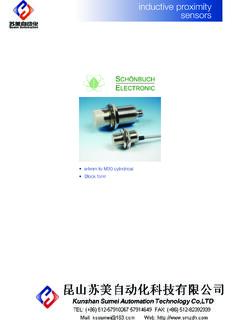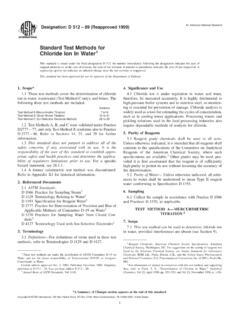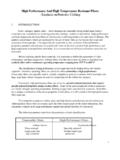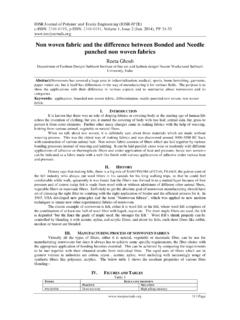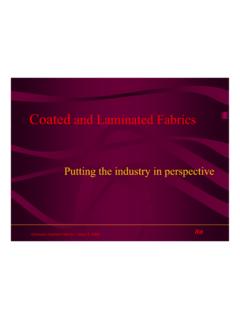Transcription of Standard Guide for Evaluating Nonwoven Fabrics
1 Designation: D 1117 01. Standard Guide for Evaluating Nonwoven Fabrics1. This Standard is issued under the fixed designation D 1117; the number immediately following the designation indicates the year of original adoption or, in the case of revision, the year of last revision. A number in parentheses indicates the year of last reapproval. A. superscript epsilon (e) indicates an editorial change since the last revision or reapproval. 1. Scope D 3776 Test Methods for Mass per Unit Area (Weight) of This Guide covers procedures for testing Nonwoven Woven Fabric3. Fabrics . The test procedures appear in the following sections: D 3786 Test Method for Hydraulic Bursting Strength of Section Knitted Goods and Nonwoven Fabrics : Diaphragm Burst- ing Strength Tester Method3.
2 Abrasion Resistance 18 D 3884 Test Method for Abrasion Resistance of Textile Absorbency 21. Air Permeability 8. Fabrics (Rotary Platform, Double-Head Method)4. Breaking Force and Elongation 9 D 3885 Test Method for Abrasion Resistance of Textile Bursting Strength 10 Fabrics (Flexing and Abrasion Method)3. Conditioning 7. Dimensional Change 20. D 3886 Test Method for Abrasion Resistance of Textile Drycleaning 11 Fabrics (Inflated Diaphragm Method)3. Flexural Rigidity 12 D 4158 Test Method for Abrasion Resistance of Textile Mass Per Unit Area (Note 2) 17. Resin Binder Distribution 22 Fabrics (Uniform Abrasion Method)3. Seam Breaking Strength 13 D 5034 Test Method for Breaking Force and Elongation of Trapezoid Tear 14 Textile Fabrics (Grab Test)3.
3 Tongue Tear (Single Rip) 15. Elmendorf Tear 16 D 5035 Test Method for Breaking Force and Elongation of Thickness 19 Textile Fabrics (Strip Test)3. NOTE 1 The terms machine and cross machine must be substi- D 5729 Test Method for Thickness of Nonwoven Fabrics4. tuted for warp and filling, respectively, throughout these test methods D 5732 Test Method for Stiffness of Nonwoven Fabrics wherever pertinent. Using the Cantilever Test3. The values stated in SI units are to be regarded as the D 5733 Test Method for Tearing Strength of Nonwoven Standard . The values given in parentheses are for information Fabrics by the Trapezoid Procedure3. only and may be approximate. D 5734 Test Method for Tearing Strength of Nonwoven This Standard does not purport to address all of the Fabrics by the Falling-Pendulum (Elmendorf) Apparatus3.
4 Safety concerns, if any, associated with its use. It is the D 5735 Test Method for Tearing Strength of Nonwoven responsibility of the user of this Standard to establish appro- Fabrics by the Tongue (Single Rip) Procedure (CRE. priate safety and health practices and determine the applica- Testing)3. bility of regulatory limitations prior to use. D 5736 Test Method for Thickness of Highloft Nonwoven Fabrics3. 2. Referenced Documents D 5908 Test Method for Resin Binder Distribution and ASTM standards : Binder Penetration Analysis of Polyester Nonwoven Fab- D 123 Terminology Relating to Textile Materials2 rics3. D 737 Test Method for Air Permeability of Textile Fabrics2 F 778 Test Methods for Gas Flow Resistance Testing of D 1683 Test Method for Failure in Sewn Seams of Woven Filtration Media5.
5 Fabrics2 Other standards : D 1776 Practice for Conditioning and Testing Textiles2 EDNA Test Method Absorption D 2724 Test Method for Bonded and Laminated Apparel 3. Terminology Fabrics2. Definitions: Nonwoven fabric , n a textile structure produced by 1. This Guide is under the jurisdiction of ASTM Committee D13 on Textiles and bonding or interlocking of fibers, or both, accomplished by are the direct responsibility of Subcommittee on Nonwoven Fabrics . Current edition approved Sept. 10, 2001. Published December 2001. Originally 3. published as D 1117 50T. Discontinued November 1995 and reinstated as D 1117. Annual Book of ASTM standards , Vol 4. Last previous edition D 1117 99.
6 Annual Book of ASTM standards , Vol 2 5. Annual Book of ASTM standards , Vol Annual Book of ASTM standards , Vol Copyright ASTM International, 100 Barr Harbor Drive, PO Box C700, West Conshohocken, PA 19428-2959, United States. 1. D 1117. mechanical, chemical, thermal, or solvent means, and combi- 6. Calibration nations thereof. Many of the test methods cited herein require the use of Discussion The term does not include paper or properly calibrated testing equipment. All testing systems Fabrics that are woven, knitted, or tufted. should be verified before being used to generate results. Refer For definitions of textile terms used in these test to the particular test method for specific information on the methods, refer to Terminology D 123.
7 Preparation, calibration, and verification of apparatus. 4. Significance and Use 7. Conditioning Refer to the particular test method cited for the property No conditioning is required unless otherwise specified. of interest for specific significance and use statements. When specified, precondition the specimens by bringing In case of a dispute arising from the differences in them to approximate moisture equilibrium in the Standard reported test values when using the test methods listed in these atmosphere for preconditioning textiles in accordance with test methods for acceptance testing of commercial shipments, Practice D 1776. the purchaser and the supplier should conduct comparative After preconditioning, bring the test specimens to tests to determine whether a statistical bias exists between their moisture equilibrium for testing in the Standard atmosphere for laboratories.
8 Competent statistical assistance is recommended testing textiles in accordance with Practice D 1776 or, if for the investigation of this bias. As a minimum, the two parties applicable, in the specified atmosphere in which the testing is should take a group of test specimens that are as homogeneous to be performed. as possible and that are from a lot of material of the type in 8. Air Permeability question. The test specimens should then be assigned ran- domly, in equal numbers, to each laboratory for testing. The Determine the air permeability as directed in Test average results from the two laboratories should be compared Method D 737. See Test Methods F 778 for additional methods using Student's t-test for unpaired data and an acceptable for testing materials other than thin flat Fabrics .
9 Probability level chosen by the two parties before the testing is NOTE 3 With highloft nonwovens, compression of the sample edges begun. If a bias is found, either its cause must be determined may affect the air permeability. and corrected or the purchaser and supplier must agree to interpret future results in the light of the known bias. 9. Breaking Force and Elongation Determine the breaking force and elongation using 5. Sampling either Test Method D 5034 or Test Method D 5035, or both. Lot Sample As a lot sample for acceptance testing, 10. Bursting Strength take at random the number of rolls, or pieces, of Nonwoven fabric directed in an applicable material specification or other Determine the bursting strength as directed in Test agreement between the purchaser and the supplier.
10 Consider Method D 3786. the rolls, or pieces, of Nonwoven fabric to be the primary 11. Drycleaning sampling units. Take the number of Nonwoven fabric rolls Determine the effect of drycleaning on nonwovens as specified in Table 1 in the absence of such an agreement. directed in Test Method D 2724. NOTE 2 An adequate specification or other agreement between the purchaser and the supplier requires taking into account the variability 12. Flexural Rigidity between rolls, or pieces, of fabric and between specimens from a swatch Determine the flexural rigidity as directed in Test from a roll of pieces of fabric to provide a sampling plan with a Methods D 5732 using the cantilever test.



